I'm studying to implement a Clock Gating in RTL. So I've followed as the below
https://www.design-reuse.com/articles/23701/power-analysis-clock-gating-rtl.html
always @(posedge clk)
begin
if (enable_in)
gclk <= clk;
end
But Problem is that I encounter an Error Message when I synthesis above code.
TOP.v:55: Clock clk used as data. (ELAB-305)
It does not makes sense Because this is just gating signal not a data. If I wrong, Could you please guide me?
How to implement Clock Gating STYLE code into RTL ?
Full Code :
module omsp_clock_gate (
// OUTPUTs
gclk, // Gated clock
// INPUTs
clk, // Clock
enable, // Clock enable
scan_enable // Scan enable (active during scan shifting)
);
// OUTPUTs
//=========
output reg gclk; // Gated clock
// INPUTs
//=========
input clk; // Clock
input enable; // Clock enable
input scan_enable; // Scan enable (active during scan shifting)
wire enable_in = (enable | scan_enable);
always @(posedge clk)
begin
if (enable_in)
gclk <= clk;
end
endmodule // omsp_clock_gate
module TOP(Clk, Reset, Crnt_Instrn, Zro_Flag, Carry_Flag, Neg_Flag, Return_Addr, Current_State, PC);
input Clk;
input Reset;
input [31:0] Crnt_Instrn; // Current Executing Inst
input Zro_Flag, Carry_Flag, Neg_Flag; // Flags from ALU or Stack
input [7:0] Return_Addr;
output [2:0] Current_State; // CurrentState from Control FSM
output [7:0] PC; // Program Count
wire Incrmnt_PC, Ld_Brnch_Addr, Ld_Rtn_Addr;
wire [2:0] CurrentState;
omsp_clock_gate u_omsp_clock_gate (
// OUTPUTs
.gclk ( gclk ), // Gated clock
// INPUTs
.clk ( Clk ), // Clock
.enable ( Neg_Flag ), // Clock enable
.scan_enable ( 1'b0) // Scan enable (active during scan shifting)
);
FSM I_FSM (
.Clk(Clk),
.Reset(Reset),
.CurrentState(CurrentState)
);
DECODE I_DECODE (
.Zro_Flag(Zro_Flag),
.Carry_Flag(Carry_Flag),
.Neg_Flag(Neg_Flag),
.CurrentState(CurrentState),
.Crnt_Instrn(Crnt_Instrn),
.Incrmnt_PC(Incrmnt_PC),
.Ld_Brnch_Addr(Ld_Brnch_Addr),
.Ld_Rtn_Addr(Ld_Rtn_Addr)
);
COUNT I_COUNT (
.Reset(Reset),
.Clk(Clk),
.Incrmnt_PC(Incrmnt_PC),
.Ld_Brnch_Addr(Ld_Brnch_Addr),
.Ld_Rtn_Addr(Ld_Rtn_Addr),
.Imm_Addr(Crnt_Instrn[7:0]),
.Return_Addr(Return_Addr),
.PC(PC)
);
assign Current_State = CurrentState;
endmodule
